
There are substantial gold resources in Central Newfoundland, people have just been slow to find them. Sokoman Minerals Corp. (TSXV:SIC) has doubled down on the Moosehead drilling program and added a second drill to unlock them.
Company president and CEO Tim Froude compares Central Newfoundland to another famous gold camp. “It’s at the point that Timmins was in 1910. The dawn of gold in Newfoundland is now,” he said.
The Moosehead project was only discovered in the late 1980s by a pair of prospectors working for Noranda. Sokoman’s discovery hole, MH-18-01 in the Eastern Trend, returned 11.9 metres at 44.96 grams gold per tonne, including 1.4 metres of 385 grams gold. Additional drilling traced the trend over 500 metres in length, 220 metres down-dip. The deposit is up to 10-metres thick and open.
The 100%-owned Moosehead project lies along the Central Newfoundland Gold Trend as does Marathon’s Valentine Lake property 150 km to the southwest. (Froude discovered the Leprechaun deposit that will likely become an open pit producer at Valentine Lake.) Sokoman has reported so many “bonanza” grades at Moosehead that Froude has been called out for using the word. But the orogenic lode gold deposit continues to deliver high grade assays.
Between the Moosehead and Valentine Lake projects, Sokoman has two other gold properties – Crippleback Lake and East Alder. Both of these have been tested with till and soil sampling and are primed for drill testing. They are both promising and the company would welcome partners to advance them.
Meanwhile, the focus remains on Moosehead. Thanks to a non-brokered private placement of flow-through shares last December, Sokoman has $4 million in its treasury, making the Phase 6 drilling program fully funded.
A remarkable feature of the Moosehead deposit is that the mineralization is virtually identical to that of Kirkland Lake Gold’s successful Fosterville mine in Australia. Froude has traveled to that site and returned with vein and host rock samples that look the same as those from Fosterville.
“If you are checking boxes and putting the two in context, the deposits have the same relative age, same rock types, comparable rock history, same vein geochemistry with antimony and arsenic,” said Froude.
Between 1990 and 2004 about 10,000 metres were cored at Moosehead, mainly to depths of less than 100 metres. Only one hole went deep and cut 278 grams gold over 0.45 metres at a depth of 257 metres.
The current Phase 6 program began in the autumn of 2020, and has been doubled to 20,000 metres with the addition of a second rig in February. Highlights include 4.6 metres of 47.20 grams gold and 8.1 metres of 68.70 grams gold in the Footwall Splay and Main zone, respectively, in hole MH-20-115. Hole 123 cut 5.0 metres of 26.88 grams gold, including 2.2 metres at 60.59 grams gold at the South Pond undercutting float material that graded 36 grams gold.
“Some of the best results have come from this phase,” Froude said, adding, “The best part of this project could be ahead of us.”
Sokoman is not yet ready to report resources at Moosehead, due to the vein-y nature of the mineralization. Only after additional drilling boosts confidence in the structures will an estimate be made. A preliminary interpretation speculates that the Western Trend and the South Pond zone converge at depth. Shear zones drilled on the property remain open in all directions.
As far as the future of gold mining in Central Newfoundland goes, “Moosehead is one of the bright lights,” said Froude. “It’s nice to see the spotlight on projects in our own backyard.”
Sokoman has a market cap of $32.2 million with 142.9 million fully diluted shares outstanding. Share were trading at $0.20 each in mid-February.
— The preceding Joint Venture Article is PROMOTED CONTENT sponsored by SOKOMAN MINERALS CORP. and produced in co-operation with The Northern Miner. Visit www.SokomanMineralsCorp.com for more information.
Comments
Gary
Jump on board before the train leaves the station!